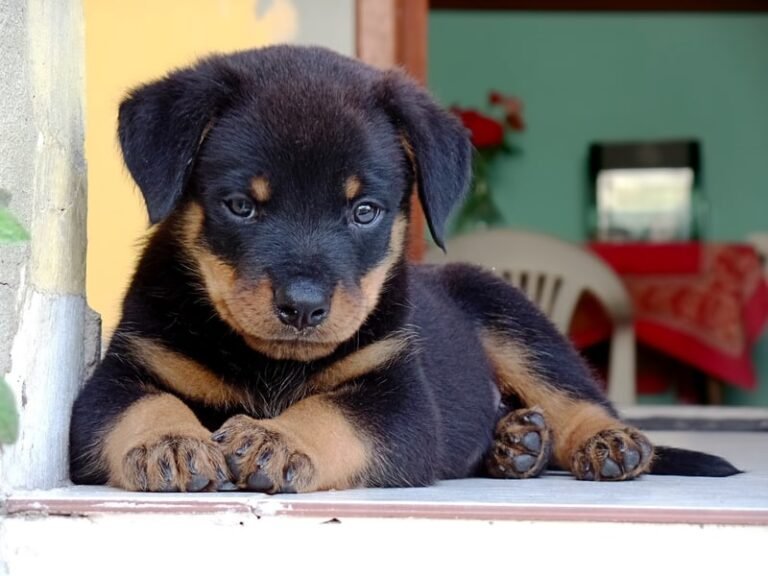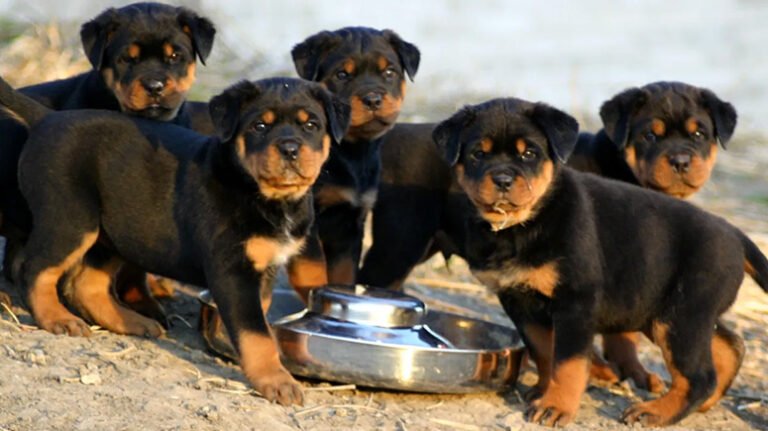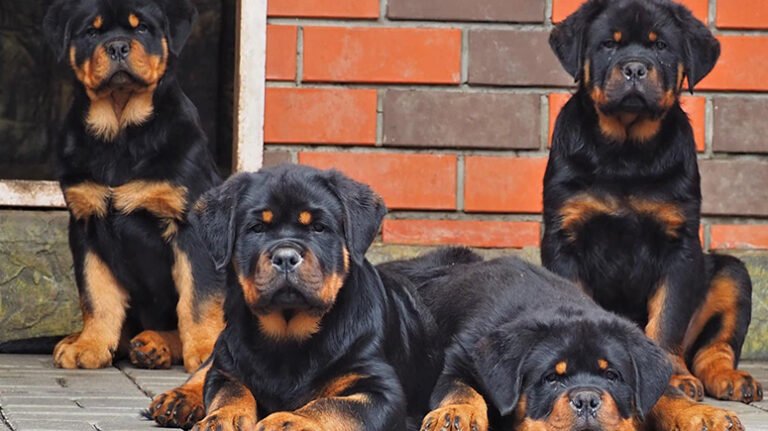Creating a Safe Space for Your Rottweiler Puppy

Introduction
Rottweilers are known for their strength, loyalty, and intelligence, making them one of the most beloved dog breeds. However, as a new Rottweiler puppy owner, it is essential to understand that these dogs need a secure and nurturing environment to thrive. Creating a safe space for your Rottweiler puppy is crucial for their emotional and physical well-being. This article will guide you through the steps needed to establish a secure environment where your Rottweiler can grow, learn, and develop into a well-adjusted adult dog.
Understanding Your Rottweiler Puppy
Before setting up a safe space, it’s vital to understand the unique characteristics of Rottweiler puppies. They are energetic, eager to please, and intelligent, yet they can also be independent and strong-willed. Recognizing their traits will help you create an environment that meets their needs effectively.
Energy Levels
Rottweiler puppies are exceptionally energetic. They require regular exercise and playtime to avoid boredom and destructive behavior. When designing their safe space, consider allocating areas for physical activities as well as quiet zones for rest.
Socialization Needs
Proper socialization is essential for Rottweiler puppies. They thrive on interactions with humans and other pets. Your puppy’s safe space should allow for positive social encounters while preventing overwhelming situations that can lead to anxiety or fear.
Designing the Safe Space
A safe space for your Rottweiler puppy must be well-defined and thoughtfully designed. Here are the essential elements to consider:
Location
Choose a location in your home that is easily accessible and relatively quiet. This space should be free from excessive noise and distractions, allowing your puppy to feel secure. A corner of a room or a designated area in your living space might work well.
Physical Space
Your Rottweiler puppy will need enough room to move around freely. Consider the following components when designing their physical space:
- Crate: A crate can serve as a safe haven for your puppy, providing a sense of security. Ensure that it’s not too small; your puppy should be able to stand up, turn around, and lie down comfortably.
- Puppy-proofing: Remove any harmful items from the area, such as electrical cords, small objects, or plants that may be toxic to dogs. Use baby gates to limit access to certain areas of the house.
- Comfort Items: Include comfortable bedding and toys. A soft bed will provide comfort and warmth, while chew toys can help with teething and mental stimulation.
Temperature Control
Ensure that the safe space is climate-controlled. Rottweilers are sensitive to extreme temperatures, so provide a space that is neither too hot nor too cold. If necessary, use fans or heaters to regulate the temperature.
Essential Supplies for Your Rottweiler Puppy
In addition to designing their physical space, it’s crucial to equip it with the right supplies for your Rottweiler puppy’s comfort and safety.
Food and Water
Make fresh water available at all times. Choose food and water bowls that are appropriately sized for your puppy. Stainless steel bowls are often recommended because they are durable and easy to clean.
Training Tools
Providing the right training tools can help you in establishing limits and expectations. Here are some basic supplies:
- Collar and Leash: A standard flat collar and a sturdy leash are essential for walks and training sessions.
- Training Treats: Use small, tasty treats to reward good behavior and facilitate training.
- Clicker: Clicker training is effective for teaching commands and reinforcing positive behavior.
Comfort Items
In addition to basic supplies, consider providing comfort items that will help your puppy feel secure:
- Blankets: Soft blankets can provide a sense of security and comfort.
- Kong Toys: Fill a durable Kong toy with treats or peanut butter to keep your puppy occupied and mentally stimulated.
- Stuffed Animals: Some puppies enjoy snuggling with soft toys. Choose safe, non-toxic options that can withstand chewing.
Establishing Rules and Boundaries
It’s important to establish rules and boundaries to create a safe and structured environment for your puppy. Consistency is key in training. Here’s how to set up rules:
Designated Areas
Clearly define areas where your Rottweiler puppy is allowed and those that are off-limits. Use baby gates to block access to certain rooms or areas. This way, your puppy will learn the difference between safe spots and restricted areas.
Positive Reinforcement
Use positive reinforcement to initiate good behavior. Reward your puppy with treats, praise, or playtime when they follow the rules. Consistent reinforcement will help your Rottweiler understand what is expected of them.
Limit Access to Unsafe Items
Monitor your puppy’s environment closely and remove or secure anything that could be dangerous. Rottweilers are strong and curious, and they might get into things they shouldn’t. Make sure that trash cans, cleaning supplies, and other hazardous materials are out of reach.
Socialization and Interaction
Socialization is essential for Rottweiler puppies as it influences their behavior as adults. Ensure that their safe space allows for positive interactions with both humans and other dogs.
Meeting People
Invite friends and family to meet your puppy gradually to help them acclimate to new people. Monitor these encounters to ensure they remain positive and stress-free.
Meeting Other Pets
Controlled introductions to other pets can also be beneficial. Consider the following:
- Supervised Playdates: Arrange for playdates with well-mannered dogs to help your puppy learn the appropriate social cues.
- Visits to Dog Parks: Once your puppy has completed their vaccinations, consider visiting a dog park where they can safely interact with other dogs.
Creating a Routine
Rottweilers thrive on routine. Establishing a consistent daily schedule will help your puppy feel secure and reduce anxiety. Key aspects of a routine include:
Feeding Schedule
Feed your Rottweiler puppy at the same times each day. This routine will help regulate their digestive system and teach them when to expect food.
Exercise and Playtime
Allocate specific times for exercise and play. Daily walks, play sessions, and interactive activities will keep your puppy physically and mentally stimulated.
Training Sessions
Incorporate short training sessions into your daily routine. Consistent training will enhance your puppy’s behavior, and it provides much-needed mental stimulation.
Monitoring Behavior and Adjusting the Environment
Regularly observe your Rottweiler puppy’s behavior and mood. If you notice anxiety or signs of stress, it may be necessary to adjust their environment. Here are some tips for monitoring and adapting your puppy’s safe space:
Behavior Monitoring
Watch for signs of discomfort or stress, such as excessive barking, whining, destructive behavior, or refusal to play. Understanding their body language can help you identify when they are overwhelmed or uncomfortable.
Environmental Adjustments
If your puppy seems stressed, consider altering their environment:
- Calming Products: Use calming sprays or diffusers with essential oils, such as lavender, in the safe space to help soothe your puppy.
- Quiet Time: Allow your puppy to have quiet time away from stimulation if they seem overwhelmed.
- Rest Areas: Ensure there are designated rest areas where your puppy can retreat to feel safe.
Health and Safety Considerations
Your Rottweiler’s health and safety should always be a top priority. Here are essential considerations:
Regular Vet Checkups
Schedule regular vet checkups to monitor your puppy’s health. Vaccinations, parasite prevention, and routine health assessments will help ensure your puppy remains healthy.
Nutrition
Feed your puppy high-quality dog food formulated for large breeds. Nutritional needs for Rottweilers may differ from those of smaller breeds due to their rapid growth and energy levels.
Grooming and Care
Implement a grooming routine that includes brushing, bathing, nail trimming, and dental care. Proper grooming will help maintain your Rottweiler’s hygiene and overall health.
Building Trust and Bonding
As you create a safe space for your Rottweiler puppy, focus on building trust and fostering a strong bond. Positive interactions will help your puppy understand that they are loved and safe.
Quality Time
Spend quality time with your puppy through play, training, and affection. Engaging in activities they enjoy will strengthen your bond. Remember to listen to their needs and respect their boundaries.
Consistency and Patience
Be consistent and patient in your approach to training and socialization. Rottweilers are capable learners, but they may require time to adapt to their surroundings.
Conclusion
Creating a safe space for your Rottweiler puppy is essential for their well-being and development. By understanding their needs, designing a secure environment, establishing routines, and focusing on training and socialization, you can provide a nurturing space where your puppy can grow into a confident and well-rounded adult dog. Remember, a loving and safe atmosphere will not only help your Rottweiler thrive but will also deepen the bond you share with your furry companion. Through consistent care, patience, and positive reinforcement, you can ensure a happy and fulfilling life for your Rottweiler.



